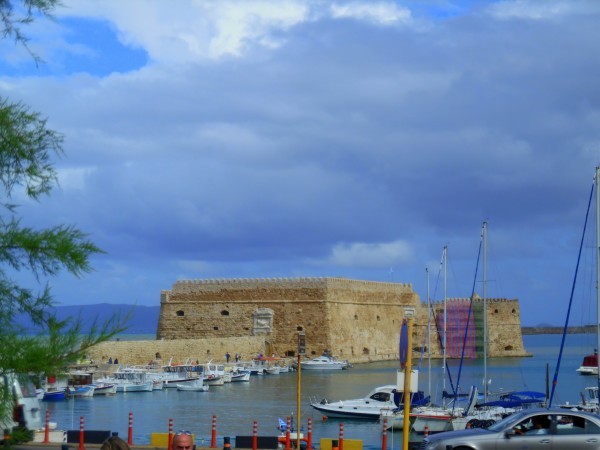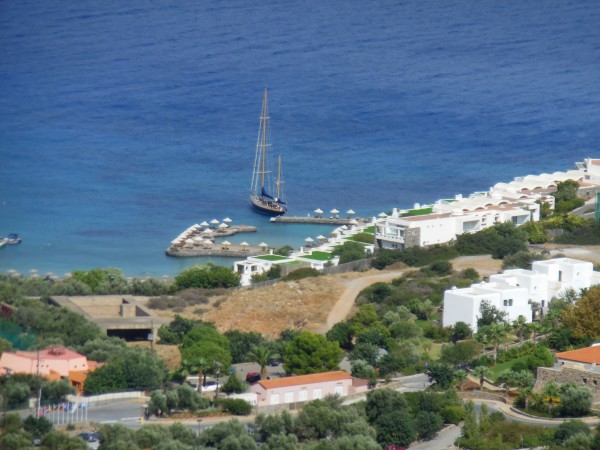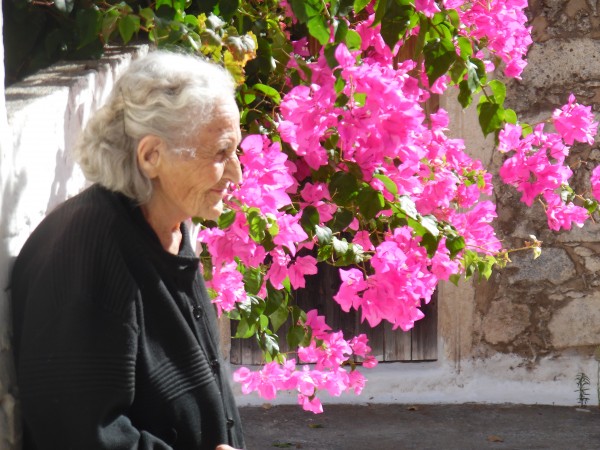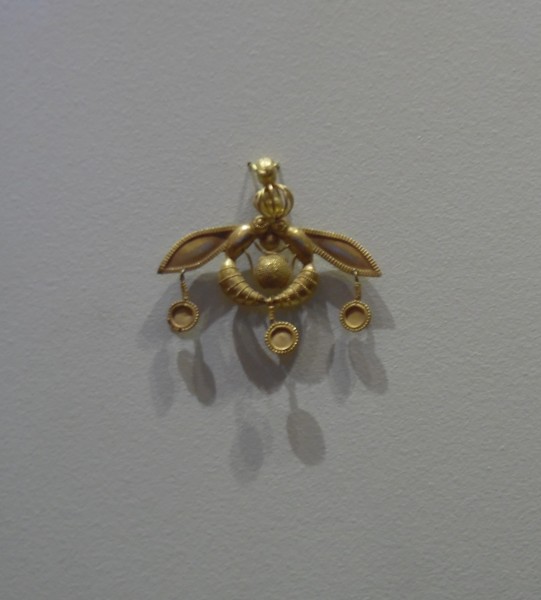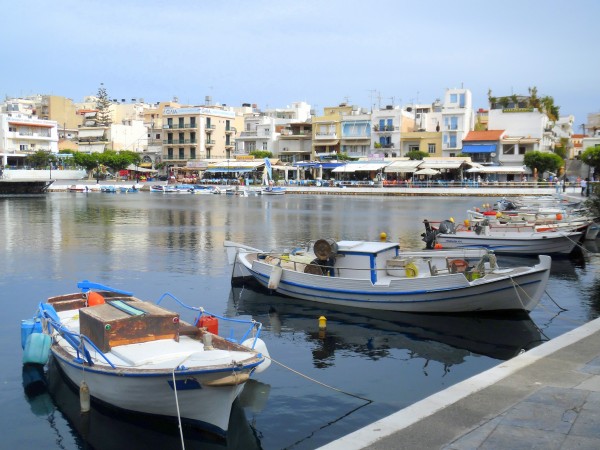Crete – the offspring of three continents and the nesting place of ancient civilisations – indeed it can be seen as the cradle of western civilisation and thus enthralling.
Crete is the fifth largest Mediterranean island and is part of Greece but it is buffeted by the Western winds, the northern winds and those that come up from the Sahara and North Africa. It sits proudly in the Mediterranean but is facing the extreme of the Aegean Sea on the north coast and the Sea of Crete and facing the Libyan Sea on its southern coast. For those of us brought up on the Greek myths and legends it boasts the birthplace of Zeus the father of gods and people….and is the birthplace of the Minoan civilisation in the centuries before BCE.
A land of extremes, wild mountains and gorges, lush plateau and stunning beaches dotted with attractive towns and ancient cities now reduced to careful heritage sites; the springtime brings forth the blooms of its floral kingdom and then the summer and autumn produce the bounty of olives, a major crop, vines and their wines, and other fruits and vegetables. This is a destination for travellers from April through to the end of October. The herbs that flourish in Eastern Crete are the beautiful aromatic thyme, savoury prickly burnet, oregano and others that exude their aroma and perfume and draw the travellers to want to purchase oils and soaps that will once they return home remind them of a sunlit happy time.
Honey is another major product and totally delicious. For me the idea of busy bees, after all iconic from the Minoan civilisation and their ornaments, working away with the herbs and flowers peculiar to Crete and producing the elixir of life….Cretan honey for the millennia is not only an awesome thought but also comforting….we are just specks in history but these important little creatures and their work endure after we are gone.
Briefly one should say that the story is that the mighty Zeus Cretagenes ‘secretly coupled’ with Europa….who allegedly gave the name to a whole continent and the result was Minoa the famous king of Knossos and ruler of the island. In all the centuries that followed there have been Arab rulers, the Venetians and the Turks….the Island has had a tumultuous past and is now quite content to be the proud largest island of Greece. During World War II the People of Crete played a heroic part in helping to defeat the Nazi forces that were sweeping through Europe and their tales of struggle, bravery and great stoicism in the face of calculated cruelty I salute. The British worked hard with them to secure peace but to this day the ‘wounds’ of that troubled desperate time are to be seen for a discerning eye.
Arriving at the Heraklion airport and driving to Agios Nikolaos on modern good roads showed us wonderful scenery and the promise of the sea and beautiful beaches. This town is charming and has the wonderful position of being in the middle of a stunning bay – the Bay of Mirabello – the name speaks for itself. Ag Nik as it is known for short is in the province of Lassithi which is the eastern province of Crete. I loved the Bay and every morning I would rise and watch the sunrise and see the pink light bathe the beautiful Mirabello in its morning blush. Lassithi is perhaps not as visited as some parts of Crete but repays closer inspection. Beach if you want, wonderful heritage sites if you choose, walking and climbing if that is what takes your fancy and a warm welcome with good food and drink for all the time you are in Crete. I like a town that is small enough in which to walk around and get the feel of the cafes and bar and tavernas, discover boutique shops, watch fishermen, watch people and just…..relax. The beaches are Blue Flag Beaches which is important for family health and this is a perfect destination for young and old.
We visited Lato which is considered to be Crete’s best preserved Classical-Hellenistic city; indeed it is considered to be one of the most important Doric city-states in Crete. We are talking of a city belonging to the 4th and 3rd centuries BC. It is a short drive from Ag Nik and one has to be able to walk up the hill to reach it. From there one has a splendid panoramic view of the mountains and valleys surrounding Lato which was fortified, and its houses were built on terraces.
It had an agora, prytaneion and temples in addition to a rock-cut theatre. This hard to reach city in those ancient times then was deserted and civilization appeared to move down to the coast to what is now Agios Nikolaos. Not very far away is an ancient hillside village of Kritsa. We visited there and enjoyed meeting the locals and their shops and village stores.
Close to the village is the historic little church of Panagia Kera, which was dedicated to the Virgin; it was probably built in the Byzantine period and expanded during the Venetian era of rule (13th century AD). All its wall surfaces were decorated with noteworthy frescoes. Even now they are impressive for the visitor but it is nice to reach there when there is no other party or coach tour as it is very small and one needs space and peace to admire and appreciate its antiquity.
We were given a tour of the Vassilakis Estate Olive Oil factory. Olive oil production is very important to Crete and the explanation of its processing was interesting. We are inclined to just take any virgin olive oil or olive oil off a supermarket shelf but here the specialities of their olive groves was explained and how like a good wine a good olive oil stands out. Naturally I bought some of their excellent olive oil soaps as a memento!
Driving down to Plaka we passed Elounga which is now very well known for its luxury villas and hotels to which world famous celebrities travel for ‘their place in the sun’. I can truly see why. Plaka has now grown and progressed but for me who read the world famous book The Island by Victoria Hislop whilst on Crete I see in my mind’s eye the village as it was pre WWII. We had a most delicious lunch of delectable dishes and enjoyed the ambiance of the popular restaurant. Then it was a short walk to a boat to take us to the Island of Spinalonga
Spinalonga is an islet situated in Elounda Bay. On top of the ruins of an ancient fortress dating back to the Hellenistic period the Venetians built a strong fortress consisting of two zones; the first followed the outline of the coast while the second was built on the rocks of the islet’s summit. Construction on this islet began in 1579 and it was constantly invaded and exploited by whoever became dominant. Muslims settled on Spinalonga in 1715 and it continued to flourish with further building. By 1881 the resident population reached 1,112 and it became the largest Muslim trading centre of Mirabello. In 1903 the Cretan State established a leper colony on the island and its first 251 patients settled there in 1904. Originally only lepers from Crete were made to go and live there but once Crete became part of Greece in 1913 lepers from the rest of Greece were deported to this little island.
The State was obliged to give these sad unfortunate people a small income and medical treatment but it was when people afflicted by leprosy in Athens and other cities were also sent here that the island began to receive more care and attention. The well connected men who became lepers from the mainland were not prepared to live out their lives without appropriate support from the authorities. The story of this place is best understood by reading the book The Island which I believe was also made into a film.
During the WWII the German occupation left the island alone and the people of Spinalonga survived largely unscathed only dying from their illness. Post war medicine progressed and researchers found a cure for leprosy and by 1957 happily those who were still resident were cured with medication and the island was officially closed down and the people returned to their previous lives. I have had to write this superficially but the story is both moving and with a cheerful end. Now because of the book and the film the people of Greece and all other tourists come here to see the island and Spinalonga still speaks to you. During my childhood in India I had encountered leprosy in extreme forms in public places so the story resonated deeply with me and I felt the Island’s atmosphere myself.
We visited a business called BioAroma which harvests the many herbs and other plants and manufactures 100% natural cosmetics. This too was interesting and for me particularly with a sound knowledge of India and its ancient Ayurvedic science and use of plants and herbs I found strong similarities.
Agios Nikolaos provided very good restaurants and entertainment in the evenings. Lake Voulismeni is the lake inshore of the harbour at Ag Nik and some say it was originally an ancient sink hole; whatever its origins this calm little lake provides a happy location for more cafes and places to eat, drink and watch the world go by. I liked it.
We drove to the extreme east of the island and visited The Toplou Monastery and Winery. This was a charming experience but also with its serious side. The Abbot graciously came out to welcome us and talked through our Guide. It is a fascinating old place that might look a little forbidding until one goes through the bougainvillea laden arches and encounters the charming outer courtyard and further courtyard. I loved it and looking at its Chapel and the art therein and then talking with the Abbot was moving. He talked about those from the Monastery who had been shot during the WWII and we reflected on the cruelty and scars of that time. The frescoes in the refectory were a delight and looking out from its high balconies on the fairly arid landscape it made one think of the centuries of men who have sought wisdom and peace and solitude in this place.
However, after a glorious sticky pastry we went and saw how the Monastery has progressed into the 21st century with a winery and is making some lovely wines. I particularly loved the sweet desert or aperitif wine and we bought ourselves a bottle.
We went to the wonderful beach of Vai and were really ready for an outstanding lunch right by the beach with the most beautiful views. Vai is strange but glorious. The area is covered naturally by wonderful palms the seeds of which must have come from Africa in the last centuries with the various invaders. They grow luxuriantly here and on the beach which is beautiful therefore it has a most exotic ambience. A graceful curving beach, lush palms, sunshine, a glorious lunch of Cretan cuisine……what more could one desire?
We visited beaches on our return journey and also passed the site of Ancient Itanos. We did not have the time to further investigate but this incredible ruin has two acropolises and had a strong presence from the Classical-Hellenistic period. Its important harbour was a resource for the Ptolemaic fleet. There is much to see here but we were expected in Sitia.
Sitia is another nice port town with pleasant views and much to commend it. The Venetian fortress of Sitia was built in the 13th century AD at the site of a Byzantine city which itself had succeeded the city of Eteia or Setaia. The Turks captured it from the Venetians but there is still much to see. There is also an archaeological museum encompassing 4,000 years of history.
For those who would play golf there is now a Crete Golf Club; the course has been built in an exciting desert style design and the designers have made every effort to protect the environment with modern water treatment plants and large untouched areas. The Crete Golf Club lies approximately 24 km east of Heraklion international airport; this means ardent golfers could find a lovely balmy place for their sport right into late October and from early March!
We ended our stay with one night at a five star hotel right next to the wonderful Archaeological Museum of Heraklion. I am so glad we did. It is outstanding and having chosen to stay adjacent to it we had no difficulty spending several hours in there. This recently renovated museum does the great pre civilisations and civilisations of Crete proud and I most strongly recommend some time spent there. The opening hours are 0800 to 20.00 until end of October which makes it really worthwhile at the end of a stay in Crete, to spend the last afternoon in this excellent place. It is only by seeing its wonderful collections that one truly appreciates the great antiquity of this beautiful island: sunshine, warmth, plethora of beaches, great archaeological sites, mountains, valleys, spring flowers, birdlife, good food and wine and the warmth of the people of Crete…..Go and Enjoy this fabulous island!!
More information can be found at tourism-lasithi@pkr.gov.gr | www.dimosagn.gr and http://www.visitgreece.gr.
Aline Dobbie is an author of four books on India and a travel writer. She lives in Scotland but travels widely throughout the year with an annual visit to India where she was born & grew up. Aline’s earlier life was in the corporate world but now lives a rural life with emphasis on travel, gardening, cooking, and family. India, South Africa, England, Scotland, Greece and other lovely places are a constant delight to her.

